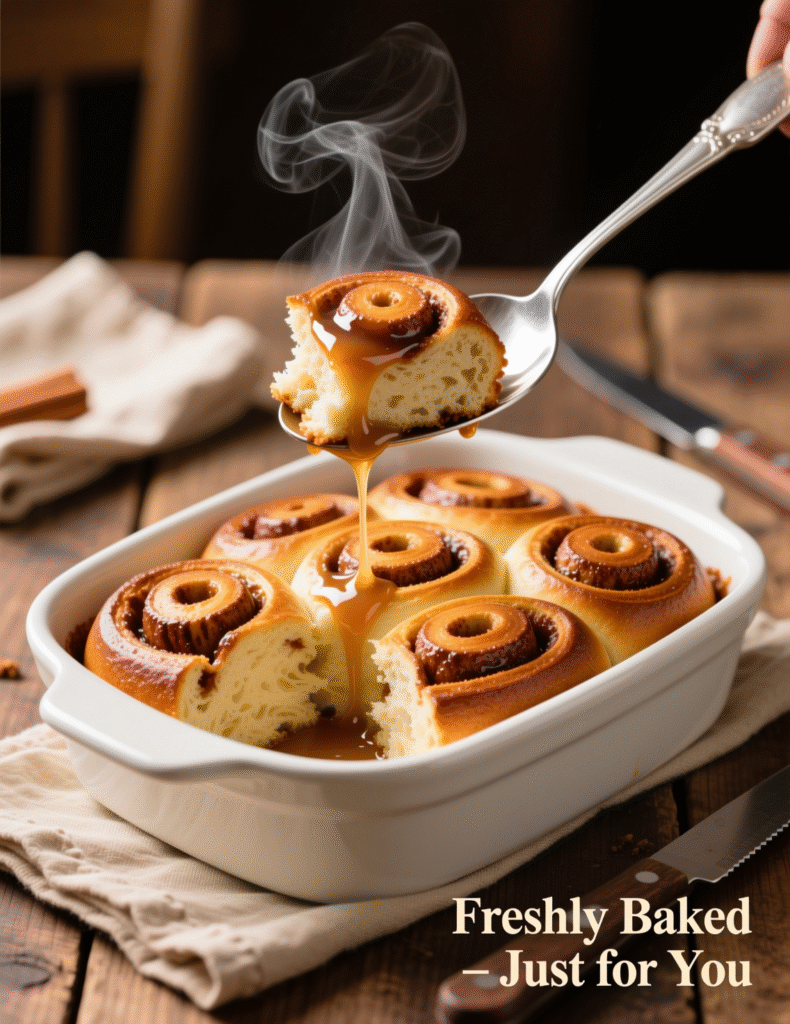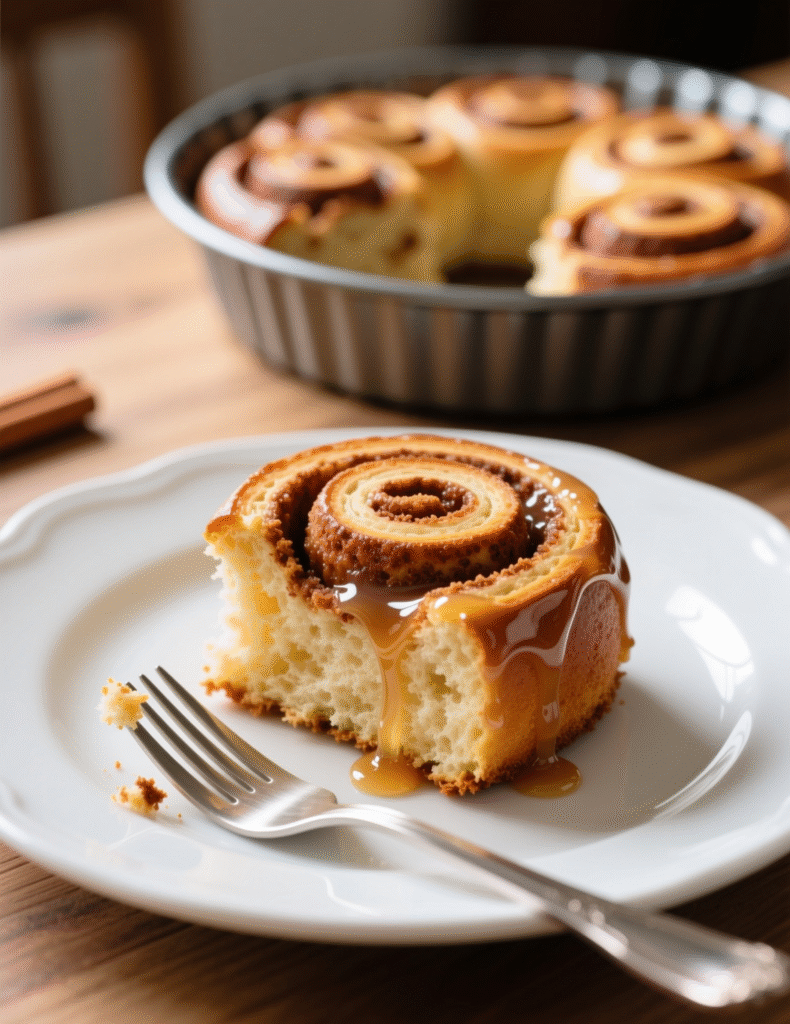There’s something about the smell of cinnamon rolls that makes kitchens feel warmer. Now imagine that same aroma baked into a soft cake that feeds twelve without the fuss of rolling dough. That’s what a cinnamon roll cake delivers—comfort, efficiency, and indulgence all in one pan. This isn’t just a recipe, it’s a blueprint for professionals who want bakery-level results with a little less labor.
Why Cinnamon Roll Cake Works So Well
Cinnamon rolls are loved, but they’re time-hungry. Yeast, proofing, rolling, slicing—it adds up. A cinnamon roll cake sidesteps most of that without losing the swirls of cinnamon-sugar goodness. Instead of dozens of rolls, you create one cake, marbled with cinnamon ribbons, finished with a glaze that seeps into every bite.
Cafés lean on recipes like this because they scale easily. Restaurants can bake several pans at once, portion them into perfect squares, and serve consistently. Families like it for gatherings—it’s quick, shareable, and can be made a few hours ahead without compromise.
Understanding the Core Components
A cinnamon roll cake has three layers of importance: the base batter, the cinnamon swirl, and the glaze. Get all three right, and the cake sings. Miss one, and it feels flat.
The base batter is typically a rich, buttery cake—something between a pound cake and a coffee cake. Professionals often enrich it with sour cream or Greek yogurt. That acidity tenderizes the crumb and balances the sweetness. The cinnamon swirl is a mix of brown sugar, cinnamon, and softened butter. Here’s where you can adjust for preference: darker sugar gives deeper molasses notes, lighter sugar tastes cleaner. And the glaze? Classic powdered sugar with milk and vanilla works, but heavy cream makes it luscious.
Ingredient Quality Matters
Let’s be blunt—cheap cinnamon tastes weak. Research from McCormick shows that Ceylon cinnamon contains subtler, complex notes while Cassia cinnamon brings bold punch. Most bakeries use Cassia for strength, but blending both creates depth.
Butter should be unsalted, fresh, and preferably high-fat European style if you want that lush crumb. Flour must be measured correctly—too much, and the cake goes dense. Many pros recommend spooning flour into a cup and leveling, or better yet, weighing it. Sugar balance also matters: white sugar for the batter, brown for the swirl. Each plays a role in structure and flavor.

Step-by-Step Expert Recipe for 12 Servings
This recipe is designed for a 9×13-inch pan, perfect for twelve equal portions.
Ingredients
For the cake:
- 3 cups all-purpose flour (375 g)
- 1 cup granulated sugar (200 g)
- 4 tsp baking powder
- 1/4 tsp salt
- 1 1/2 cups whole milk
- 2 large eggs
- 2 tsp vanilla extract
- 1/2 cup unsalted butter, melted
For the swirl:
- 1 cup brown sugar, packed
- 2 tbsp cinnamon
- 2/3 cup unsalted butter, softened
For the glaze:
- 2 cups powdered sugar
- 5–6 tbsp milk or cream
- 1 tsp vanilla extract
Method
- Preheat oven to 350°F (175°C). Grease a 9×13-inch baking dish.
- In a large bowl, whisk flour, sugar, baking powder, and salt.
- Mix in milk, eggs, vanilla, and melted butter until smooth but not overworked.
- Pour batter into the prepared dish.
- In another bowl, combine brown sugar, cinnamon, and softened butter until spreadable.
- Drop spoonfuls of the cinnamon mixture over the batter. Swirl lightly with a knife to create ribbons.
- Bake for 35–40 minutes, or until a toothpick in the center comes out clean.
- While warm, whisk glaze ingredients until smooth. Pour over cake, letting it soak slightly.
- Cool for 10–15 minutes before cutting into 12 portions.
Troubleshooting and Professional Adjustments
Sometimes the swirl sinks. That happens if butter is too soft or if you over-swirl. Aim for ribbons rather than mixing. Another issue? Dry cake. That’s often due to overbaking or too much flour. A foodservice tip is to check cake doneness 5 minutes early—every oven runs slightly different.
Scaling up is simple. Double the recipe for sheet pans. Just remember baking time will extend, sometimes by 10–15 minutes. If you’re baking for a café, cooling completely before slicing ensures neat squares for display.
Cinnamon Roll Cake Trends
Interestingly, cinnamon desserts rank in the top five comfort bakes in Google Trends each winter. Searches for “cinnamon roll cake” spike around December and Easter. Professionals ride that trend by offering limited seasonal twists—pumpkin spice swirl in fall, or orange zest glaze for spring.
Plant-based versions are booming too. Oat milk works well in the batter, while vegan butter substitutes can handle the swirl. Aquafaba or flaxseed “eggs” add structure for dairy-free menus. According to Innova Market Insights, vegan bakery products are projected to grow by 7% annually through 2028.
Serving and Pairing Insights
Cinnamon roll cake is versatile. Cafés serve it alongside cappuccinos, pairing the spice warmth with coffee bitterness. At brunch events, it sits well with savory balance—think quiche, bacon, or fruit salad. For a plated dessert, top a warmed slice with a scoop of vanilla gelato.
Professionals often cut the cake into squares, but rectangles look generous on buffet trays. Drizzling extra glaze just before serving creates shine and refreshes appearance, especially if cake sat a few hours.

Nutritional Considerations
Each serving (1/12th of the cake) clocks in at roughly 350–380 calories depending on glaze thickness. About 15g fat, 55g carbs, and 5g protein. That’s comparable to a standard cinnamon roll, but portion control feels easier in cake form.
Adding nuts like pecans or walnuts not only boosts nutrition but also adds crunch. Using half whole-wheat flour increases fiber content. For professionals marketing “better-for-you” options, swapping part of the sugar for coconut sugar or reducing glaze quantity appeals to health-conscious buyers.
Expert Tips That Change Everything
Always use room temperature ingredients. Cold milk or eggs cause the butter to seize, resulting in uneven mixing. For deeper flavor, bloom cinnamon in melted butter before mixing into the swirl—it enhances aromatic oils. Another trick: bake the cake on the middle rack, avoiding hot spots that brown edges too fast.
Storage matters too. Leftovers keep at room temperature for 2 days covered, or in the fridge for 5 days. Reheat slices slightly to revive softness. Freezing works as well—wrap tightly, thaw overnight, and glaze just before serving for best results.
Addressing Common Misconceptions
Some think cinnamon roll cake is just “lazy cinnamon rolls.” That’s missing the point. It’s not about skipping effort, it’s about delivering a different eating experience. Instead of tearing into individual rolls, you get a moist, sliceable cake with that same nostalgic taste.
Another misconception is that it lacks the yeasty flavor of rolls. True, it’s not yeasted bread. But the cake compensates with richness from butter, vanilla, and cream. Some professionals even add a touch of instant yeast for aroma, though it doesn’t impact structure.
Variations Professionals Explore
Apple-cinnamon roll cake is a bestseller in many bakeries—fold diced apples into the batter for moisture. Caramel drizzle instead of glaze turns it into a more decadent dessert. Chocolate chips in the swirl create a mocha-style version that pairs beautifully with espresso.
Even savory variations exist. Imagine swapping cinnamon sugar for cheese, herbs, and garlic butter. Same method, entirely different profile. This adaptability is why professionals keep it in rotation—it’s a foundation recipe, not just a one-hit bake.
Final Thoughts
Cinnamon roll cake for 12 servings is more than a recipe. It’s a professional solution that merges flavor with efficiency. The right balance of batter, swirl, and glaze creates a cake that satisfies customers, impresses guests, and scales effortlessly for businesses.
If you’re a home baker, this cake lets you capture the spirit of cinnamon rolls without early-morning dough rolling. For professionals, it’s an easy addition to menus that delivers comfort food appeal. Play with the variations, understand the science of each component, and you’ll find endless ways to make it your own.
FAQs
How many servings does this cinnamon roll cake recipe make?
It makes 12 even servings in a standard 9×13-inch pan.
Can I make this cake ahead of time?
Yes, you can bake it a day before and reheat or glaze just before serving.
What type of cinnamon works best for this recipe?
Cassia brings bold flavor, while Ceylon offers subtle notes—use either or a blend for depth.
How do I keep the cake from drying out?
Don’t overbake and store it covered at room temperature or chilled.
Can I freeze cinnamon roll cake?
Yes, wrap tightly and freeze up to 2 months; glaze after thawing.
Is it possible to make this recipe vegan?
Yes, substitute oat milk, vegan butter, and flaxseed eggs for a plant-based version.
Why does my cinnamon swirl sink to the bottom?
It happens if butter is too soft or if the swirl is over-mixed into the batter.
What’s the best way to serve cinnamon roll cake?
Cut into squares and drizzle with glaze, serve warm with coffee or ice cream.
Can I scale this recipe for a larger crowd?
Yes, double it for sheet pans but extend baking time slightly.
How long can leftovers last?
Up to 2 days at room temperature, or 5 days refrigerated when properly covered.

Marie Smith is a passionate recipe blogger, sharing easy, delicious, and creative culinary ideas that inspire home cooks to elevate everyday meals with flavor and simplicity.
